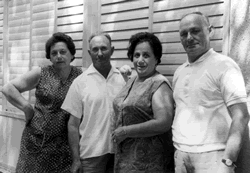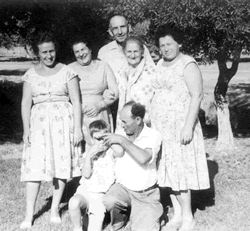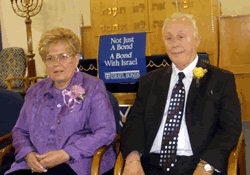#chvln-1:
From right to left: rescued Arye-Leib (Leon) Chevlin and his wife Basya nee Katz visiting relatives in Kibbutz Dafna. the 1960-es
Credit: scanned at Yad Vashem. returned to Hasya Brin, kibbutz Dafna
Lhttp://www.eilatgordinlevitan.com/dolhinov/d_pages/d_stories_chevlin.html
The Story of Simon Chevlin
#chvln-2:
Brajna Katz ( mother of Basya Chevlin) with her daughter and grandchildren, 1966?
#chvln-3:
Jack Chevlin has lived a life of danger and accomplishment and devoted his retirement years to giving back to others.
? a famed band of Belarusian partisans hiding from the Nazis. As an adult he taught music to thousands of students at Roselle Park High School. In later years in Monroe, he has helped raise more than $200,000 for disabled Israeli veterans.
“I like to go to minyan Saturday morning and thank God for my survival and being able to help other people,” said Chevlin, who was honored with his wife, Ethel, at the annual Israel Bonds luncheon July 18 at the Jewish Congregation of Concordia in Monroe, where he served as longtime ritual committee chair.
He previously attended Temple Beth O’r/Beth Torah in Clark.
Chevlin, who took up the accordion and saxophone while in a displaced persons’ camp in Germany after the war, continued with his music education after his uncle — a Bronx dentist — brought his family to New York.
Chevlin earned scholarships for bachelor’s and master’s degrees and made a career teaching middle- and high-school instrumental music.
Grateful officials in Roselle Park, where he lived and taught for 28 years, made him grand marshal for several holiday parades.
After moving to Monroe 12 years ago, Chevlin became president of the Monroe Township Holocaust Survivors, staging an annual musical show to raise money for Beit Halochem (House of the Soldier) rehabilitation centers in Israel.
In a phone interview with NJ Jewish News, Chevlin recounted how his family was saved by Nikolay Kiselev, a soldier in the Red Army who was taken prisoner but escaped in 1941, joining the Belarusian partisans in German-occupied territory.
Kiselev took out about 270 inhabitants of the Jewish settlement of Dolginovo after most had been slaughtered. Only 218 survived the arduous journey. Chevlin was eight or nine when he and his siblings — brothers Simon and Nachman and sister Sylvia — went into the forest with their parents, grandmother, and two cousins. Nachman was later killed while fighting with the Russian Army.
In 2005, Kiselev was posthumously recognized by Yad Vashem as Righteous Among the Nations, and was the subject of a 2008 Russian documentary, Kiselev’s List.
Chevlin spoke June 28 at the Chabad Jewish Center of Monroe following a showing of the movie.
Chevlin has also shared his story with Steven Spielberg’s Survivors of the Shoah Visual History Project at the University of Southern California and the Holocaust Resource Center of Kean University.
He remembers the day Nachman and several others were on guard duty, when the Germans entered the forest and the group was told to scatter quickly.
“We were being attacked by planes, artillery,” recalled Chevlin. “I was just running very fast. I heard somebody screaming and I turned around. It was my grandmother who had been hit by shrapnel in both legs. Blood was gushing everywhere.”
The young boy froze. “Then, from out of nowhere, I saw my father running,” he recalled. The elder Chevlin took the grandmother’s kerchief and tied it around her legs, and threw her over his shoulder. Father and son ran to a predetermined spot where they were all told to gather if ever separated.
The next morning the partisans told the family they would have to leave the grandmother behind as they moved on “or we would all die.”
The family tearfully left her, never expecting to see her again. Miraculously, after the war, the Chevlins learned she had survived with help from the partisans “who loved my grandmother,” and the family was reunited.
Marching more than 600 miles in a 10-week trek over mountains, through forests, and crossing rivers the group fled toward the Russian border. They suffered in small towns in subfreezing temperatures and fled to Poland at war’s end. His father bribed a guard to allow them into Czechoslovakia, where they were arrested and sent to Austria. Several months later they went to the displaced persons’ camp.
Among those saved by Kiselev, Chevlin’s extended family alone can count more than 200 descendants, including his own children. “I think we were meant to survive,” he said.


